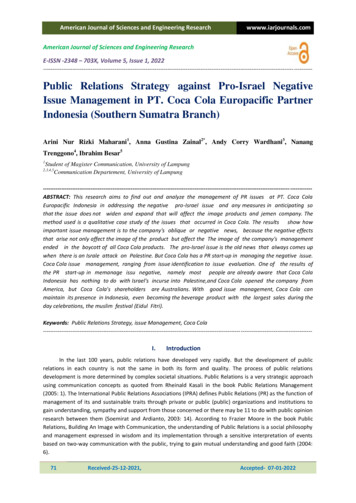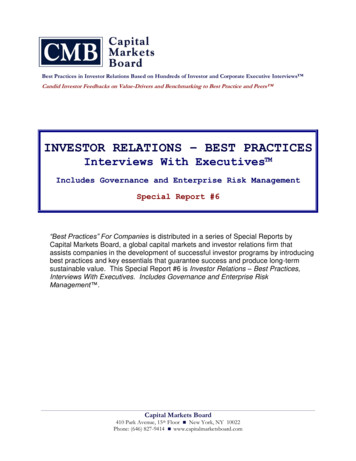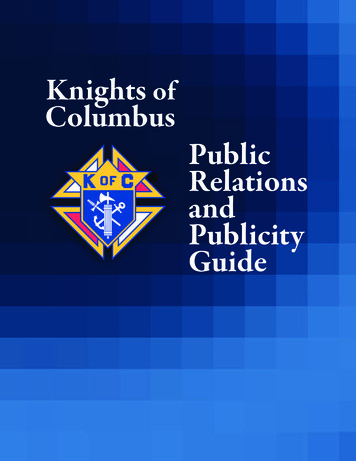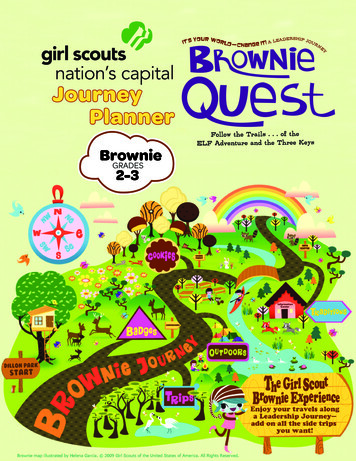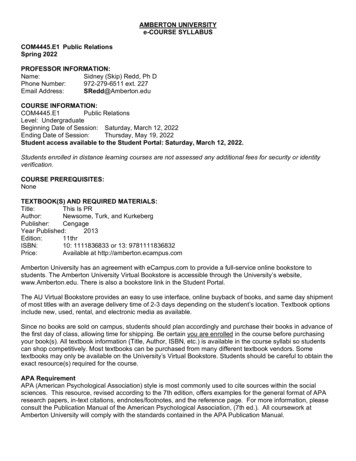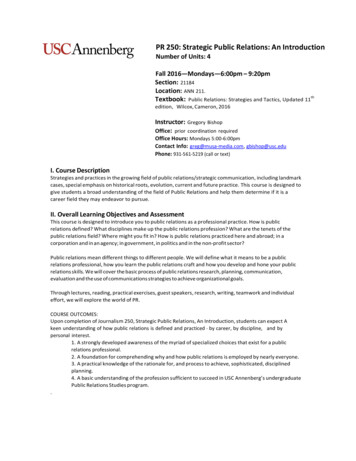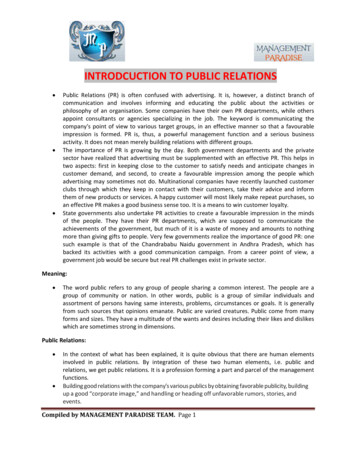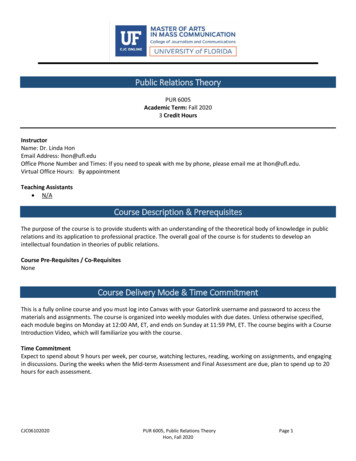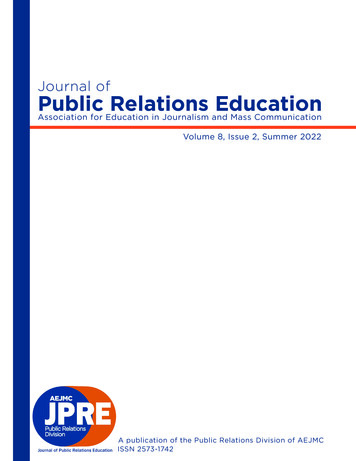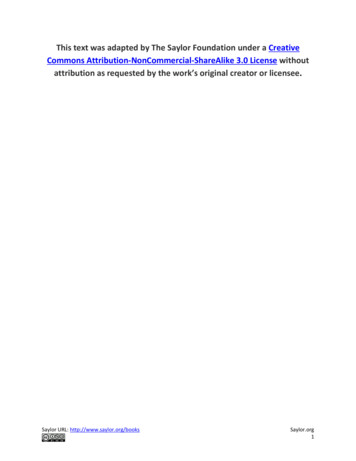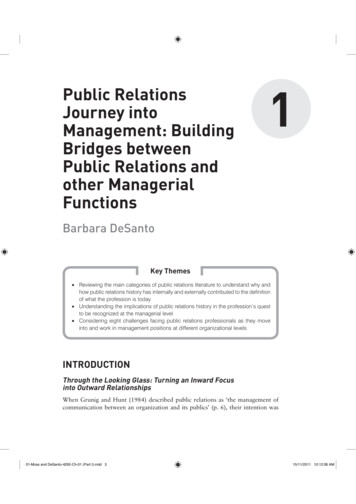
Transcription
Public RelationsJourney intoManagement: BuildingBridges betweenPublic Relations andother ManagerialFunctions1Barbara DeSantoKey Themesv Reviewing the main categories of public relations literature to understand why andhow public relations history has internally and externally contributed to the definitionof what the profession is todayv Understanding the implications of public relations history in the profession’s questto be recognized at the managerial levelv Considering eight challenges facing public relations professionals as they moveinto and work in management positions at different organizational levelsINTRODUCTIONThrough the Looking Glass: Turning an Inward Focusinto Outward RelationshipsWhen Grunig and Hunt (1984) described public relations as ‘the management ofcommunication between an organization and its publics’ (p. 6), their intention was01-Moss and DeSanto-4292-Ch-01 (Part I).indd 315/11/2011 10:12:06 AM
FRAMEWORKS AND CONTEXTS4undoubtedly one of seeking to position public relations as a mainstream ‘managerial’function within organizations, to be treated on a par with the other more traditionalorganizational functions such as human resource management, finance, production,and marketing. While perhaps recognizing that such a claim for equal status in thefunctional hierarchy within organizations might prove controversial, it is highlyunlikely that Grunig and Hunt would have forecast the degree of debate and controversy that has gradually emerged around the use of the term ‘management’ todescribe the function and practice of public relations. Indeed, public relations scholars perhaps saw little reason to view the use of the term ‘management’ per se as at allcontroversial; yet as we will show later, by the time that Grunig and Hunt’s bookwas published, a long-running debate was already well under way among management scholars about the nature of management and managerial work. It is not, however, our intention to challenge the basic premise contained in Grunig and Hunt’sdefinition or any of the many other definitions of public relations, namely, that public relations should be treated as a ‘managerial function’ as opposed to a largely communication oriented, technical function. Moreover, we acknowledge and supportthe arguments that for public relations to be fully effective in a managerial role, practitioners need to have access to and influence among the senior management teamwithin organizations. However, as a number of academic and professional commentators have pointed out, such access and influence has to be earned, and here weargue that this demands that practitioners demonstrate the necessary skills and business acumen to deserve their place at the ‘top table’ within organizations. What weintend to do within this book is to examine in more depth what the ‘management’ ofpublic relations involves, what management practices and processes are involved,and what skills and competences those aspiring to be communication/public relations‘managers’ need to possess or develop.The Excellence ConceptPerhaps the single most influential piece of extended research that has been conducted into public relations practice over the past two decades has been the so-calledExcellence Study conducted by James and Larissa Grunig and their co-researchers,which set out to address the fundamental question of ‘How, why, and to what extentdoes communication affect the achievement of organizational objectives?’ (Grunig,Grunig, & Dozier, 1992: 2). In articulating some 14 principles of ‘excellent’ publicrelations, the research team emphasized the importance of having public relationsrecognized as a distinctive ‘management function’ in its own right, and argued thatsenior practitioners should have access to and participate in the strategic decisionmaking process within their respective organizations. However, it clear that inadvancing their theoretical framework, the excellence team was concerned almostexclusively with the most senior levels of management and with the ability of publicrelations to function effectively at that level by contributing to strategy and policymaking within organizations. While acknowledging the importance of such seniorlevel involvement for public relations, as many studies have shown, such involvement remains far from the ‘norm’ found in most organizations where public01-Moss and DeSanto-4292-Ch-01 (Part I).indd 415/11/2011 10:12:06 AM
PUBLIC RELATIONS JOURNEY INTO MANAGEMENT5relations is often still treated as a largely functionary and tactical function. Moreover,we also believe that this emphasis on public relations involvement at the ‘strategic decision-making level’ within organizations tends to overlook the need to also examinepublic relations ‘management’ as manifested at the operational/departmental levels. Infact, if we are to develop a comprehensive theory of communication/public relations management there is a need to explain and understand both the strategic andoperational dimensions of management as manifest in different levels of publicrelations practice. Indeed, management scholars (e.g. Hales, 1986, 1999; Mintzberg,1994; Stewart, 1976, 1982) have acknowledged that much management time isspent on what is often quite ‘messy’, largely tactical and operational activities, ratherthan dealing with the more rarefied levels of policy and strategy formulation. Thisdistinction between tactical and strategic management work is something againwhich we intend to clarify, examining how these terms apply in the context of publicrelations work.The Public Relations Society of America’s Manager DescriptionAn interesting perspective on the application of the management concept in thepublic relations context can be seen in the Public Relations Society of America(PRSA) Professional Career Guide (1993) (see Figure 1.1), which describes the interpretation of the various career levels in public relations work. Here, the term ‘manager’ is identified as the middle level of the five career levels, which like Gruniget al.’s excellence model, suggests that some time and experience in the practice areneeded before it is possible for practitioners to assume managerial responsibility.The PRSA’s description of managerial work provides a useful reference point indeveloping our explication of managerial work and managerial responsibilities atdifferent levels within organizations, and in particular, how they apply in publicrelations work.The Career Guide’s description of a public relations manager focuses on skills andknowledge needed to be a manager, including responsibility for ‘planning, organizing, directing, and motivating staff, budgeting, problem-solving and problem identification. Managers must be able to ‘sell’ programs, both inside the department and inother areas of the organization. They often conduct meetings and make presentations or speeches, analyze situations and develop plans of action’ (PRSA, 1993: 4).Thus, in developing our perspective of the manager’s role and managerial work inthe communication/public relations context, we have drawn on both the existingacademic and professional literature to help formulate what we believe is a morecomprehensive and effective framework for examining the work of practitionersoperating at different levels within organizations and therefore, by implication, having different levels of responsibility in terms of both tactical/operational and morestrategic managerial tasks and challenges.Here, the PRSA Professional Career Guide provides a useful basis for examiningthe types of tasks typically performed as a combination of strategic and tactical,representative of both the levels below and above the managerial level (see Figure1.2).01-Moss and DeSanto-4292-Ch-01 (Part I).indd 515/11/2011 10:12:06 AM
FRAMEWORKS AND CONTEXTS6EXECUTIVEDIRECTORMANAGERSUPERVISOR 2SUPERVISOR 1SUPERVISORTECHNICIAN 2ENTRY-LEVELTECHNICIANTECHNICIANNote: In 1993 the Public Relations Society of America (PRSA) developed a career progression structure for practitioners. Each step was defined by roles and responsibilities. Theemphasis in this book is on the manager/director levels.FIGURE 1.1 The PRSA Five Levels of Career PracticeSource: Public Relations Professional Career Guide 1993 by The PRSA Foundation.In this book we attempt to provide insights into how public relations practitioners can address such managerial challenges, which will enhance not only theindividual practitioner’s status, but also the status of the profession. Armed withthis knowledge, we believe practitioners will be better equipped to manage thecommunication/public relations function more effectively while also demonstratinga general level of managerial competence comparable to that of managerial-levelstaff from other functions within the organization.01-Moss and DeSanto-4292-Ch-01 (Part I).indd 617/11/2011 11:37:54 AM
PUBLIC RELATIONS JOURNEY INTO MANAGEMENTMANAGERGENERAL RESPONSIBILITIES:Responsible for departmental operations andfor constituency and issue trend analysis.Necessary skills include planning, organizing,leading, evaluating, problem solving andconsulting.TITLES AND JOB DESCRIPTIONS:Manager of Internal CommunicationsThe person in this position manages all “mass’’communications with employees. The functionoften includes periodical publications,newsletters, magazines, video programs,speeches and specialized materials designedto communicate with employees.Manager ofMember RelationsThis title is used inMANAGERmembershiporganizations suchas associations andsocieties, where members are a specialconstituency and are as important ascustomers or shareholders in other types oforganizations. The function usually includesresponsibility for newsletters, magazines,issues papers, the organization’s annualreport, audiovisual presentations, and(sometimes) special materials related to theorganization’s annual membership conference.7Community Relations ManagerManages public relations activities relatedto the locations where the organization hasa major presence. This includes the citywhere the organization is headquartered aswell as locations regional/district offices,distribution and manufacturing facilities. Incorporations, this function generallyincludes liaison with local news mediar themanagement of the company’s corporatecontributions program, and planning andconducting major special events.Manager of ResearchResponsible for managing all activities related tothe gathering of information needed inmanagementdecision-making, aswell as in theproduction ofpublications,audiovisualpresentations andspeeches.Manager of Audiovisual CommunicationsManages all activities and personnel involved inplanning and producing videotape and multimediapresentations intended to convey specificmessages to a precisely/defined constituency.Issues ManagerManages activities related to communicatingthe company’s financial matters to investors,stock brokers and financial analysts.Manages the function responsible forgathering information on political, economicand social trends that may affect the future ofthe organization and its products. Thefunction may be staffed, or services may beprovided by outside sources.Manager of Marketing CommunicationsOTHER TITLES:Manages the preparation of marketing-relatedcommunications materials, public relationsand promotions. In consumer productorganizations marketing activities maydominate the public relations function, andcorporate public relations may serve primarilyin the area of investor relations.Typical titles in public relations andadvertising agencies;Director of Public RelationsDirector of Account ServicesIn management consulting firms:Director of Communication ServicesDirector of Media RelationsManager of Investor RelationsFIGURE 1.2 PRSA Descriptions of Managerial ResponsibilitiesSource: Public Relations Professional Career Guide 1993 by The PRSA Foundation.01-Moss and DeSanto-4292-Ch-01 (Part I).indd 717/11/2011 11:38:11 AM
FRAMEWORKS AND CONTEXTS8Developing an Identity and Finding anOrganizational Home: Learning from the PastThings often make more sense when we understand what has preceded the position/situation we find ourselves in right now. So it is with public relations. Only when wefully appreciate how public relations itself has come to be understood, including howprofessionals and academics think about it as a concept, function, or discipline, is itpossible to carry out a meaningful examination of what it means to manage in thepublic relations context and what the challenges are that public relations managersface. This section looks back at the last four decades of public relations research byacademics and professionals to identify the main perceptions of public relations as astarting point to use in moving into the managerial ranks.By the time that Grunig and Hunt’s (1984) book was published, public relationshad begun to emerge from journalism and communication studies curricula as anacademic discipline in its own right. By the latter quarter of twentieth century, publicrelations had become established as a full-fledged, stand-alone major course of studyin colleges and universities, beginning in the United States in the 1970s and 1980s,followed by rapid curriculum growth in many parts of Europe in the late 1980s and1990s. Now, in the twenty-first century, academic programs of study in public relations can be found in countries around the world. Such rapid growth in the numberand sophistication of academic and professional training programs in public relationscan be seen as an indicator of the growing recognition afforded to public relations asan established ‘management-level’ discipline within the business world, albeit thatsuch recognition may vary from sector to sector, between organizations, as well asvarying across cultures and contexts around the world.The establishment of formal academic programs in public relations has generated aplethora of academic research focusing on public relations from a variety of perspectives, including the ongoing development and maturing of the profession and practiceas it earned its way into different management levels. Perspectives ranged from theeffects of gender on managerial or technical roles (e.g., Toth & Grunig, 1993; Creedon,1991; Choi & Hon, 2002), through the development of the four-step process at different levels of management (e.g., Cutlip & Center, 1971) and the boundary-spanningcapabilities of public relations practitioners (e.g. Aldrich & Herker, 1977; Jackson &Center, 1975), to the concept of relationship management as a function of public relations (Ledingham & Bruning, 2000; Grunig & Repper, 1992).A FRAMEWORK FOR REVIEWING THE PUBLICRELATIONS LITERATUREUnderstanding what research has been completed in the public relations field provides a useful framework within which to develop this book on public relations management. Pavlik (1987) produced one of the first assessments of what research hadbeen done and what research directions might be useful, and Public Relations Review,01-Moss and DeSanto-4292-Ch-01 (Part I).indd 815/11/2011 10:12:11 AM
PUBLIC RELATIONS JOURNEY INTO MANAGEMENT9one of the leading public relations academic journals devotes one of its issues to anannual index of research articles and publications in the field. I have developed aframework for categorizing the public relations literature into a number of core thematic areas which, although used primarily as a teaching aid, also serves as a usefulway of framing the literature.I reviewed a wide range of sources along with other indices covering more than30 years of public relations research, dividing the identified material into fourbroad thematic categories (see Figure 1.3): (1) public relations as a concept or idea;(2) public relations as a function; (3) public relations as a process; and (4) public relations as a role. These four distinct but related areas are important because each contributes to building an overall perspective of what public relations is and what itshould and can do. Moreover, arguably each of these thematic areas also contributeto building an understanding of the ‘messy’ work of public relations management,where functions, departments, and managers overlap in their work.The outer four areas of the model represent four interrelated areas of research that,when viewed together, reveal something of the contested nature of our understandingPUBLICRELATIONSAS ANIDEA/CONCEPTPUBLICRELATIONSAS AROLETHE PRACTICEOFMANAGEMENTPUBLICRELATIONSAS AFUNCTIONPUBLICRELATIONSAS APROCESSFIGURE 1.3The Four Categories of Public Relations Research01-Moss and DeSanto-4292-Ch-01 (Part I).indd 915/11/2011 10:12:11 AM
FRAMEWORKS AND CONTEXTS10of public relations as a discipline, as a form of professional practice, and as a set ofwork-related roles that practitioners perform. Here I have pointed to the strong selfreflecting inward focus of much of this research, with little attention paid to exploring the external context and/or environment outside of the public relations fielditself. The concept of ‘management’ in the public relations context has admittedlybeen discussed in some depth, particularly within the roles literature, but often without drawing comparisons with how management is understood in other functionaldisciplines, most notably within the mainstream management literature.For the purposes of this book, we have placed the concept and practice of management at the center of this model to focus attention on understanding whatmight constitute the tasks and responsibilities of those practitioners occupying‘managerial level’ roles within organizations; this may also help to highlight whereand how practitioners can make substantial contributions to the achievement ofbroader organizational objectives at all levels of management, not just at the mostsenior level. Public relations practitioners who begin to think beyond theirown functional area and link their communication objectives to the business/organizational objectives of other managers are then in a position to demonstratethe impact that communication/public relations can and should have in organizations. In short, they can participate in the conversation where strategy is developedand implemented.Category 1: Public Relations as a Concept/IdeaThe first of these categories or areas contains literature concerned with publicrelations as a ‘concept or idea’, and here researchers have sought to uncover asingle universal definition of public relations. In essence, agreeing on one definition has the potential benefit of facilitating clearer recognition of what publicrelations is and stands for. In the 1940s, American practitioner and PRSA founding member Rex Harlow (Cutlip, Center, and Broom, 1985) undertook the monumental task of gathering together all of the definitions of public relations he couldfind. From the nearly 500 definitions that he catalogued, he worked with thefledgling PRSA to create one ‘official’ definition that he hoped would be sufficiently broad yet sufficiently definitive to be universally recognized and accepted.The resulting definition (see Figure 1.4), while comprehensive, was not terriblymemorable or useful as a shorthand way of explaining public relations to a wideraudience. And, of course, while the PRSA and other professional bodies may havesimilar official definitions, this has not stopped academics and professionals fromcontinuing to devise new definitions, which may add to the lack of clarity aboutwhat the term ‘public relations’ stands for. Of course, the challenge of identifyingone universal definition is made all the more difficult by the realization that public relations practice and people’s understanding of it may well vary in differentenvironmental or organizational contexts, as well as over time and in differentcultures, all of which suggests there may be a need to at least adapt how publicrelations is defined.01-Moss and DeSanto-4292-Ch-01 (Part I).indd 1015/11/2011 10:12:11 AM
PUBLIC RELATIONS JOURNEY INTO MANAGEMENT11OFFICIAL STATEMENT ON PUBLIC RELATIONS(Formally adopted by PRSA Assembly, November, 1982)Public relations helps our complex, pluralistic society to reach decisions and function moreeffectively by contributing to mutual understanding among groups and institutions. It serves tobring private and public policies into harmony.Public relations serves a wide variety of institutions in society such as businesses, tradeunions, government agencies, voluntary associations, foundations, hospitals, schools, collegesand religious institutions. To achieve their goals, these institutions must develop effectiverelationships with many different audiences or publics such as employees, members,customers, local communities, shareholders, and other institutions, and with society at large.The managements of institutions need to understand the attitudes and values of their publics inorder to achieve institutional goals. the goals themselves are shaped by the externalenvironment. The public relations practitioner acts as a counselor to management and as amediator, helping to translate private aims into reasonable, publicly acceptable policy and action.As a management function, public relations encompasses the following:vvvvvvAnticipating, analyzing and interpreting public opinion, attitudes, and issues that mightimpact, for good or ill, the operations and plans of the organization.Counseling management at all levels in the organization with regard to policy decisions,courses of action, and communication, taking into account their public ramifications and theorganization’s social or citizenship responsibilities.Researching, conducting, and evaluating, on a continuing basis, programs of action andcommunication to achieve the informed public understanding necessary to the success ofan organization’s aims. These may include marketing, financial, fundraising, employee,community or government relations, and other programs.Planning and implementing the organization’s efforts to influence or change public policy.Setting objectives, planning, budgeting, recruiting and training staff, developing facilities – inshort, managing the resources needed to perform all of the above.Examples of the knowledge that may be required in the professional practice of publicrelations include communication arts, psychology, social psychology, sociology, politicalscience, economics, and the principles of management and ethics. Technical knowledgeand skills are required for opinion research, public-issues analysis, media relations, directmail, institutional advertising, publications, film/video productions, special events, speeches,and presentations.In helping to define and implement policy, the public relations practitioner uses a variety ofprofessional communication skills and plays an integrative role both within the organization andbetween the organization and the external environment.FIGURE 1.4PRSA Statement of Public RelationsSource: Formally adopted by PRSA Assembly, November 6, 1982 ions.On the other hand, scholars such as Hutton (1999) have warned that unless public relations finds a way to develop one recognizable identity, it will continue to berelegated to the more technical ranks of practice charged with carrying out thedecisions largely taken by others.While the idea of finding one universally acceptable definition of public relationsmay prove an impossible challenge, what seems a more logical and achievable goal is01-Moss and DeSanto-4292-Ch-01 (Part I).indd 1117/11/2011 11:38:28 AM
FRAMEWORKS AND CONTEXTS12Characteristic of Excellent Public Relations ProgramsI. Program Level1. Managed strategicallyII. Departmental Level2.3.4.5.6.7.A single or integrated public relations departmentSeparate function from marketingDirect reporting relationship to senior managementTwo-way symmetrical modelSenior public relations person in the managerial rolePotential for excellent public relations, as indicated by:a.b.c.d.Knowledge of symmetrical modelKnowledge of managerial roleAcademic training in public relationsProfessionalism8. Equal opportunity for men and women in public relationsIII. Organizational Level9.10.11.12.13.14.Worldview for public relations in the organization reflects the two-way symmetrical modelPublic relations director has power in or with the dominant coalitionParticipative rather than authoritarian organizational cultureSymmetrical system of internal communicationOrganic rather than mechanical organizational structureTurbulent, complex environment with pressure from activist groupsIV. Effects of Excellent Public Relations15. Programs meet communication objectives16. Reduces costs of regulation, pressure, and litigation17. Job satisfaction is high among employeesFrom Excellence in Public Relations and Communication Management (1992), edited byJames E. Grunig, Lawrence Erlbaum Associates. Hillsdale, NJ, p. 28.FIGURE 1.5 Grunig, Grunig, and Dozier’s Characteristics of Excellent Organizationsto move toward the idea of identifying some more or less common core characteristics of public relations practice and the associated professional skills required ofpractitioners. For example, Guth and Marsh (2003) propose that the elements of‘management function’, ‘two-way communication’, ‘planned activity’, ‘researchbased social science’, and ‘socially responsible’ behavior form the core elements ofany definition of public relations (p. 7). Wilcox, Cameron, Ault, and Agee (2003)identify the key words to defining public relations as including: ‘deliberate, planned,performance, public interest, two-way communication, and management function.’(p. 5). Clearly these examples show that while the context and environment cangreatly vary, the concept displays consistent elements and values. Similarly, as wehave already pointed to earlier, one of the key outcomes of the ‘excellence study’ wasthe identification of a set of key characteristics of excellent communication and public relations practice, as shown in Figure 1.5 (Grunig, 1992; Grunig et al., 1992).01-Moss and DeSanto-4292-Ch-01 (Part I).indd 1215/11/2011 10:12:12 AM
PUBLIC RELATIONS JOURNEY INTO MANAGEMENT13Category 2: Public Relations as a FunctionThe second category of literature focuses on the idea of public relations as a functionthat relates to the purpose for which public relations exists. Here the literature looks atwhat public relations should or can contribute to the organization’s overall goals andobjectives and in what specific and general ways. Examples include public relations asthe conscience of the organization (social responsibility and reputation management),the organizational mouthpiece (media relations), the environmental scanner (issuesmanagement or environmental interpreter), or, one of the most often cited, the boundary spanner. Grunig et al. (1992) maintained that the level at which these functions areperformed affects whether the practitioner is thought of as a ‘manager’ or a ‘technician’, although their focus was limited to identifying the truly excellent organizationsand the senior executives in them. Nevertheless, the logic here is that the location ofthe function within the organizational hierarchy is likely to reflect the dominant coalition’s perceptions of public relations which, in turn, will have a significant influence onhow far practitioners are able to enact a predominantly managerial rather than technical role. In addition to its relationship with the dominant coalition, public relationsmust also define its position and contribution in relation to other mainstream organizational functions and levels, such as marketing, human resources, legal, and finance.Interestingly, ‘crisis management’ is the one of the areas that appears fairly welldefined as the responsibility of the public relations function. One plausible explanation for this link between public relations and crisis management is the often verystrong media component present in crisis situations. This harkens back to publicrelations roots as a ‘journalist-in-residence’ function (Grunig & Hunt, 1984: 22),when organizations attracted journalists into becoming advocates for them becauseof their well-developed understanding of the media and how to use it for organizational objectives. Even in crisis situations, however, the level at which the function iscarried out depends on the organization’s understanding of the public relations function. At one extreme public relations might operate simply as a ‘mouthpiece’ fordisseminating the company line supplied by dominant coalition members, while atthe other extreme public relations practitioners may play an active part in helping toconstruct strategically important messages that might impact significantly on theorganization’s short- and long-term objectives. Crisis management also provides aninteresting insight into how fluid yet crucial the functional level of public relationscan be. During a crisis, public relations is often sought out by dominant coalitionmembers for ideas and input, yet once the crisis declines in intensity, public relationsmay often be relegated to fulfilling a much more routine role within the organizationuntil the next crisis flares up. Figure 1.6 shows typical titles and responsibilities thePRSA has identified as functions of public relations managers.Category 3: Public Relations as a ProcessThe third category/area of literature concerns the view of public relations as a ‘process’. This area has attracted significant research interest over the years as scholarshave attempted to map, explain and conceptualize the public relations process. Here,01-Moss and DeSanto-4292-Ch-01 (Part I).indd 1315/11/2011 10:12:12 AM
FRAMEWORKS AND CONTEXTS14MANAGERTYPICAL TITLES:Issues ManagerManager of Audiovisual CommunicationsManager of Community RelationsManager of Corporate CommunicationsManager of Internal CommunicationsManager of Investor RelationsMana
When Grunig and Hunt (1984) described public relations as 'the management of communication between an organization and its publics' (p. 6), their intention was Key Themes v Reviewing the main categories of public relations literature to understand why and how public relations history has internally and externally contributed to the definition
